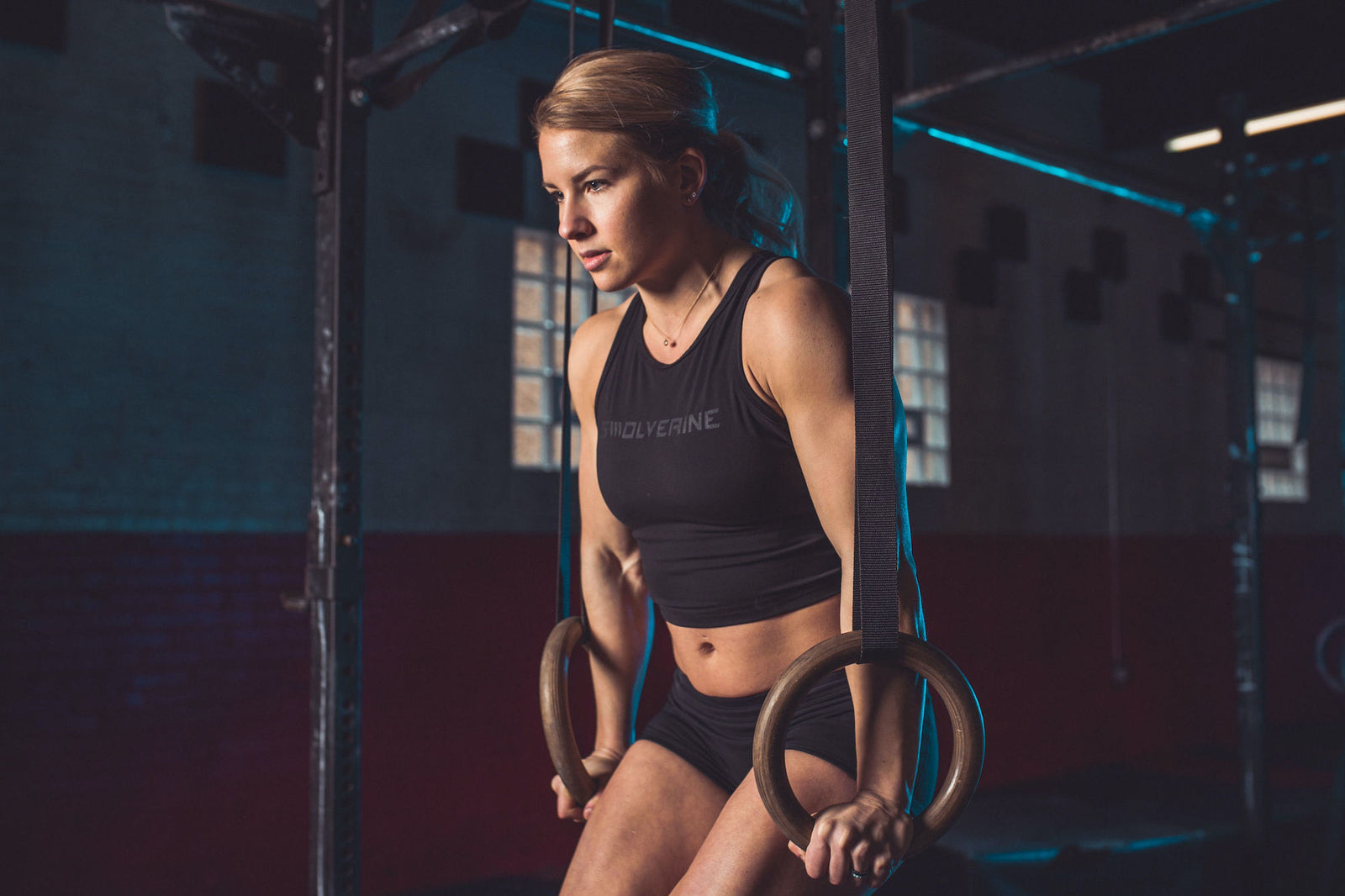If you find ring dips to be hard, you’re not alone. After all, they’re a difficult move to master, requiring patience, practice, and good form to create muscle memory and strength. While ring dips are one of the most fundamental gymnastics movements, they’re often one of the most overlooked and incorrectly practiced movements. In this ultimate guide to ring dips and ring dip variations, we’re going to help you learn the basics to become a master in no time.
What is a Ring Dip
The standard, static ring dip is a compound exercise designed to work the muscles of the upper body simultaneously. Ring dips are unique in that the gymnastic rings create instability. In doing so, the movement recruits more muscles to support the body through the movement. Ring dips are much more difficult than standard dips, but they’re also a safer option for the joints and more rewarding than standard bar dips.

What Muscles Do Ring Dips Work
Ring dips are a great strength and stability building exercises, primarily focused on working the triceps with a secondary focus on the chest and shoulder muscles simultaneously. As mentioned previously, ring dips are more friendly to the joints as compared to bar dips. As the rings rotate through the movement, the joints are able to track naturally through the movement, creating less pressure and friction within them.
RELATED: The 6 Best Supplements For Building Muscle Mass & Strength
What Are Ring Dips Good For
Ring dips aren’t just a good movement for building strength in the muscles around the shoulders and building serious muscle mass for bodybuilders; ring dips are also an essential movement for cross-fitters and progressing into more technical CrossFit movements, like bar muscle-ups and ring muscle-ups. By regularly working on form and strength, you can improve joint health, flexibility, body control, and even help prevent injury.
How To Do A Ring Dip
Performing a ring dip is a relatively simple concept.
- Grab a set of gymnastics rings
- Jump up, supporting yourself, with your elbows locked out and thumbs slightly turned out, establishing a safe shoulder position
- Lowering yourself into a bottom position, keeping the elbows on top of the wrist
- Press back up, finishing in a lockout
Who Should Do Ring Dips
Just about anyone should, and can, do ring dips. Whether you’re looking to build strength, stability, or to progress in your training, give them a try.
RELATED: How to Get Stronger In 3 Simple Steps

Ring Dips in CrossFit
The ring dip in CrossFit is essential for developing the upper-body strength required for more advanced gymnastic movements. If you can’t do 8-10 strict ring dips, chances are, you shouldn’t be even attempting ring muscle-ups.
Disclaimer: If you fail to demonstrate proper strength and control through strict gymnastic movements, before moving into kipping movements, you may put yourself at a higher risk for unnecessary injury as well as joint and connective tissue stress as a result of poor technique.
Ring Dips Progressions
One of the hesitations about training on gymnastics rings is that many people jump into the full movement without first building strength, mind-muscle connection, or muscle memory from progressive movements. Ring dips require an incremental progression of force and stress that requires more preparation and concentration as compared to other static movements. This is why we recommend the following variations to start and build where your body and ability allow, encouraging you to be more mindful of your training, not just what the programming says to do for the day.
Ring Dip Progression: Stationary Dips
The stationary dip is a stable movement designed to help you work through the same range of motion as the ring dip, minus the major control or strength to manage the rings. After you practice stationary dips, then the next progression would be moving to the rings, which will make stabilization a bit more difficult.
Ring Dip Progression: Static Hold
After moving from stationary dips to the rings, before you start dipping your heart out, practice your static holds. Ideally, you want to become familiar with the body control needed for dips by holding the movement for 20-30 seconds, with your shoulders slightly externally rotated, and your pinky fingers pointing to your thighs. Be patient here, and progress onward when comfortable.
RELATED: How Many Sets and Reps You Should Do To Increase Performance
Ring Dip Progression: Strict Dips
It’s imperative to master strict dips before moving into any type of kipping movement. This ensures that your joints, connective tissues, and body coordination are ready to support the necessary strength, your body, and neurological motor control before getting more advanced with the movement. There’s nothing worse than getting injured because you weren’t prepared enough, skilled enough, or strong enough to do the movement in the first place.
RELATED: 11 Annoying Reasons Why You're Not Gaining Muscle Mass
Ring Dip Variations
Tempo Ring Dips
Tempo training is a great way to build time under tension while developing the strength for the full range of motion within the ring dip movement. It’s important to stress that the tempo must remain the same for both the eccentric and concentric portion of the ring dip movement.
Elevator Ring Dips
Elevator ring dips isolate the pieces of the movement for maximal control and strength building.
Band Assisted Ring Dips
Using bands also help stabilize the body through the movement in a controlled manner. You can use bands alone or with the help of a coach in order to ‘scale’ the ring dip movement.
Leg-Assisted Ring Dips
A great ring dip variation is the leg-assisted ring dip where you actually use a box off to the side of one leg for stability through the ring dip movement. These
Kipping Ring Dips
Once you’ve mastered the progressions, it’s time to move into kipping ring dips. It’s important to note that these are called ‘kipping’ and not ‘kicking’, as the most important part of the movement is bringing the knees up towards the chest with intention, rather than kicking them down and away from the body, which is a common mistake for beginners.
How to Do Kipping Ring Dips:
- Lower yourself to the top of the rings
- Driving your knees straight upwards toward your chest, push yourself out of the bottom of the ring dip
- Lockout at the top, lowering your legs back down, and repeat the movement
Weighted Ring Dips
Why add weight to an already hard movement? Well, at some point, you may need to in order to effectively increase the intensity and development of your strength through the ring dip movement. Weighted ring dips can be performed with a weighted vest, dipping belt around the waist, or by holding a dumbbell, kettlebell, or medicine ball between the legs or feet.

Bulgarian Ring Dips
Bulgarian ring dips are a ring dip progression for advanced athletes looking to take a more targeted approach to increase shoulder stability, prevent injury, and further chest development. This variation primarily focuses on working the pectorals, anterior deltoids, triceps, core, and scapular stabilizers. In this movement, the rings are wider than a regular ring dip, as they descend with the back of the arms parallel to the floor, before bringing the hands back to the body.
Ring Dips Conclusion
In conclusion, ring dips are a great way to help athletes and aspiring athletes maximize their fitness, strength, coordination, stability, and gymnastic potential. With these ring dip variations, you can target the movement at any level of ability. With patience and practice, ring dips don’t have to be as challenging of a movement as they are for you today.
Do your muscles get pumped out and fatigued when you're practicing gymnastic movements?
SWOLVERINE IS AN ENDURANCE ATHLETE AND ACTIVE LIFESTYLE BRAND. MADE FOR THE ELITE ATHLETE, AND THE STRONG-WILLED OUR PRODUCTS WERE DESIGNED TO FUEL YOUR ATHLETIC PERFORMANCE. WE PERFORM WHEN YOU PERFORM.
We believe that everyone can optimize not only their athletic performance but their human potential. The way we believe we can optimize performance is through transparency, clinically effective doses, and clinically proven ingredients with evidence-based outcomes. We provide the nutrients you need to power your active lifestyle.








